Do it because you can!
Register for the Navy 10K today and get early bird pricing. The whole family can participate!
Register for the Navy 10K today and get early bird pricing. The whole family can participate!
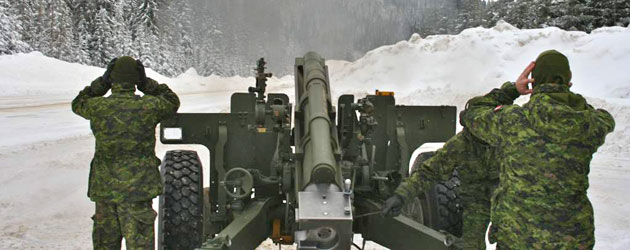
Operation Palaci personnel load and fire the 105mm Howitzer artillery cannons for avalanche control in the Selkirk Mountains.

A French military light armoured vehicle exits the ramp of a Canadian Forces CC-177 Globemaster III aircraft at the airport in Bamako, Mali. French forces have begun a mission to stabilize security in the African nation.

Members of the Naval Boarding Party from HMCS Regina, deployed in their Ridged Hull Inflatable Boat, communicate with the crew of a dhow in the Arabian Sea, during Operation Artemis.

[caption id="attachment_3325" align="alignnone" width="300"] The 80-year-old Craigflower bridge is due to be replaced this year and will result in further traffic delays during its closure from Mary to December, 2013. The above image is an artist’s rendering of the new bridge.[/caption] Time is running out for the 80-year-old timber trestle Craigflower Bridge as the District of Saanich and the Town of View Royal are readying to replace it with a modern, aesthetic and functional steel bridge. The bridge will be closed from approximately May 1 to Dec. 1, 2013. The first phase, the construction of a temporary pedestrian bridge for local school children and cyclists, begins April 15.In anticipation of the bridge closure, commuters to the base are encouraged to look at alternatives to using their vehicles for travelling to and from work, as it is expected traffic around the bridge will be substantially disrupted.“We closed Admirals Road in 2009 when we built the bridge over Colquitz, so we have a pretty good idea of what’s going to happen,” says Jim Hemstock, project manager at the Saanich District Engineering Office. “About 80 per cent of people will have to go over to Tillicum and about 20 percent will go the other way over toward Helmcken or Six Mile.” This will cause traffic choke points in those areas and significant delays surrounding Craigflower Road, Admirals Road and Lampson Street. The evening traffic is anticipated to be even less appealing with heavy trucks coming from the base being diverted onto Craigflower Road, essentially transforming Island Highway and Helmcken Road into temporary truck routes. The good news is there are alternatives for commuters to avoid the traffic chaos, especially for those in the Western Communities travelling to CFB Esquimalt. For example, the Victoria Regional Transit System has bus routes (#6, #24, and #25) departing...

[caption id="attachment_3322" align="alignnone" width="300"] Members of the Naval Boarding Party from HMCS Regina, deployed in their Ridged Hull Inflatable Boat, approach a fishing dhow.[/caption] The Gulf of Aden, situated between Yemen and Somalia, contains one of the world’s busiest shipping lanes. With an average of 21,000 ships transiting annually, it is part of the waterway that connects the Mediterranean Ocean with the Arabian Sea. Determining which of these ships is engaged in legitimate commerce and which may have more detrimental intentions is one of the challenges faced by Combined Task Force 150 (CTF-150).CTF-150 is part of the Combined Maritime Forces (CMF) and consists of ships from countries such as Australia, Canada, Pakistan, the United Kingdom and the United States. Tasked with counter-terrorism and maritime security operations, the task force works to prevent and stop illicit activity in the region. HMCS Regina, Canada’s contribution to CTF-150, is currently conducting what is referred to as maritime interdiction operations. The aim of these patrols is to prevent illicit activity by observing and investigating the local shipping activity. By determining the normal trade routes and routines of the various types of vessels that pass through the region every day, CMF is better able to determine which activity is suspicious or illegal.A typical patrol consists of recording and observing the behavior of the region’s merchant mariners. In order to gain the information about the vessels, the crew uses many tools available, such as the ship’s radar and Sea King helicopter. The Sea King’s primary function is to extend the range of the ship’s sensors by surveying the area of operations. A secondary function is to help determine if other vessels in the vicinity are behaving suspiciously.In addition, local information can be gained by talking to mariners. This is accomplished by hailing the vessel and communicating...
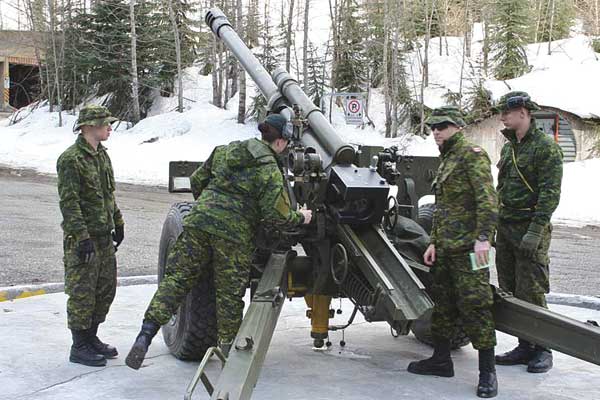
[caption id="attachment_3317" align="alignnone" width="300"] Operation Palaci personnel load and fire the 105mm Howitzer artillery cannon used by Operation Palaci for avalanche control in the Selkirk Mountains.[/caption] Operation Palaci is the contribution by the Canadian Forces (CF) to Parks Canada’s avalanche-control program in Rogers Pass, where the Trans-Canada Highway and the Canadian Pacific Railway cross the Selkirk Mountains.The objective of Operation Palaci is to prevent naturally occurring avalanches, and to ensure road and rail links between coastal B.C. and the rest of Canada are not blocked.This is done by firing shells from C3 105mm Howitzer cannons into rock formations to reduce natural avalanches. “If Parks Canada is surprised by an avalanche, roads and railways can stay closed for days,” says MBdr Rebecca Bliss-Roth, a member of 10th Field Regiment Artillery unit of Regina, Saskatchewan, who has been stationed in the Rogers Pass since Nov. 21. “This way they’re ready for them and can clear the road relatively quickly while keeping the pass safe.” So far this season, 52 controlled avalanches have been triggered and 82 rounds have been fired.Op Palaci draws upon reserve and regular forces members from across Canada. The first rotation started Nov. 21 and includes members from BC, Alberta, Manitoba, and Saskatchewan. They are stationed in a Parks Canada compound near the Rogers Pass Discovery Centre. The compound includes separate rooms for each participant, a full kitchen, full laundry, and common room with amenities such as satellite TV and movies. Despite these creature comforts MBdr Bliss-Roth says cabin fever tends to set in from time to time.“We’re basically in the middle of nowhere. The nearest town is something like 30 kilometres away, so we don’t really get out there too often.”When not performing avalanche control, military personnel undertake periods of professional development, occasionally busying themselves in the woodworking...
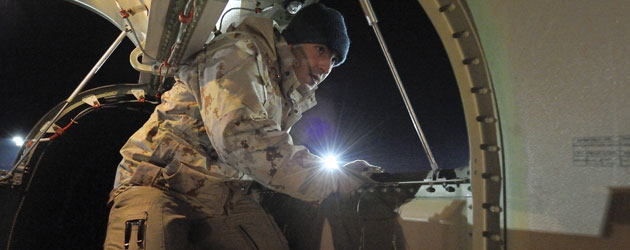
A Canadian Forces Globemaster III aircraft commander checks the wings and tail for frost from the tail hatch at Base aérienne 125 Istres-Le Tubé in Istres, France on route to Bamako, Mali.
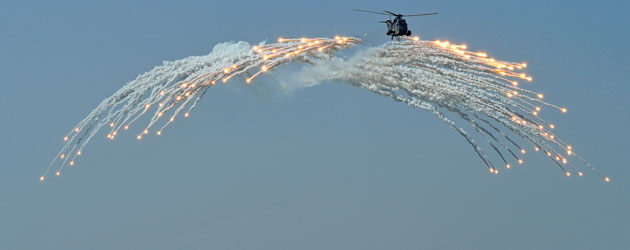
A Sea King helicopter from HMCS Regina fires flares during an exercise while on Operation Artemis in the Arabian Sea.
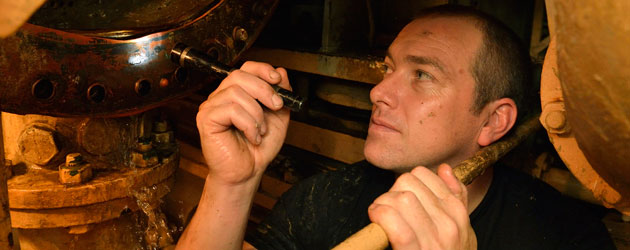
Marine Engineer, OS David Blanchard, performs maintenance in the forward engine room on board HMCS Regina, while deployed in the Arabian Sea for Operation Artemis.
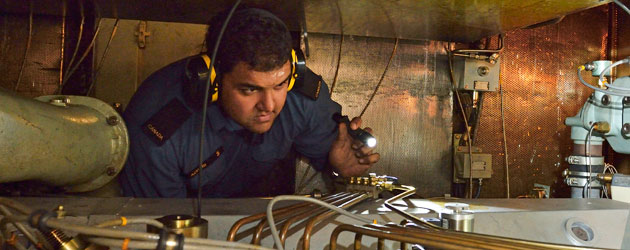
Marine Engineer, OS Lionel Achari on board HMCS Regina inspects an engine while deployed in the Arabian Sea for Operation Artemis.
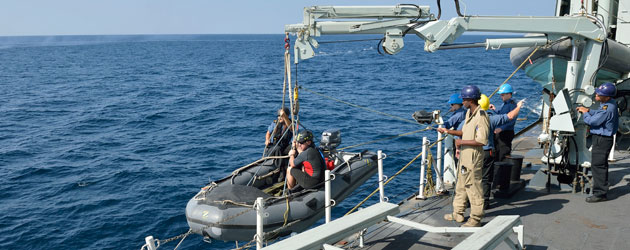
Members of HMCS Regina deploy a Zodiac during a man overboard exercise while on Operation ARTEMIS in the Arabian Sea.

[caption id="attachment_3271" align="alignnone" width="300"] Maritime Forces Pacific (MARPAC) Fleet Chief Petty Officer, CPO1 Paul Helston; MARPAC Chief of Staff, Capt(N) Mike Knippel; and Commander MARPAC, RAdm Bill Truelove sport pink t-shirts in support of International STAND UP to Bullying Day on Friday, Feb. 22.[/caption] CFB Esquimalt will join thousands of schools, workplaces and organizations this year when it officially participates in International STAND UP to Bullying Day next month.The driving force behind the event, MCpl Kyle Mitchell, hopes to see a sea of pink shirts on Friday, Feb. 22, which is “dress with a difference” day, as military members and civilians show support for the cause.“I’d hope for everyone to be wearing pink shirts, but because this is the first time, I’m just happy the base has authorized it,” he says.Inspired by his two children who are actively involved in anti-bullying programs in their school, MCpl Mitchell decided to take action to make people on base more aware of bullying, its effects and programs that address it.“I know we in CFB Esquimalt have systems in place to assist our members and families, but I was surprised to find out that my own wife was unaware of them,” he says. The Military Family Resource Centre, the padres, the divisional system, the Employee Assistance Program, the Canadian Forces Members Assistance Program and CF Mental Health Services all offer assistance to people experiencing bullying. Several of these programs are available to families as well as DND employees.MCpl Mitchell knew the opportunity to take his own action against bullying had arrived during a luncheon with Commander Maritime Forces Pacific, RAdm Bill Truelove early last year.“He challenged all of us present to take a look at ourselves, at the base, and see if there is anything that we are doing that we can do better,...

[caption id="attachment_3268" align="alignnone" width="300"] Canadian Forces volunteers including CPO1 Dan Ferguson (centre) gather to deconstruct the home of Rishi Sharma (left) and family.[/caption] Crowbars were hefted and sledgehammers swung when Canadian Forces members lent a helping hand deconstructing a home for Habitat for Humanity.On Jan. 13 a crew consisting of a CF members, homeowners, and Habitat for Humanity employees aided in stripping a Saanich house to the studs. The goal: to recover all salvageable materials so they can be recycled by Habitat for Humanity’s ReStore.“We’ve worked with Habitat for Humanity before, so when they called us it was a no brainer,” says CPO1 Derek Ferguson, who headed up the team of CF volunteers. “We’ve helped them at their store before, but we’ve never helped them tear down a house.”The house, which was already slated for destruction, was set upon by the crew and stripped of all valuable building materials; everything from cabinets and doors to light fixtures and door knobs was torn out and taken away to Habitat for Humanity’s ReStore.“The homeowner wanted to make sure his house was being dealt with in the most environmentally conscious way,” says CPO1 Ferguson. “He was involved in many steps of the process to ensure that everything that could be done was being done.”Deconstruction involved plenty of smashing and crushing, something that CPO1 Ferguson and the crew were elated to be a part of.“It was great fun. It’s not something that you get to do every day,” he says. “The homeowner even came in and helped with some of it. Everyone had a great time.”At the end of the day, the team filled two moving trucks with salvageable materials.“The materials that we gathered will be kept out of the landfills and hopefully be used to build or renovate some homes,” says CPO1 Ferguson....

[caption id="attachment_3265" align="alignnone" width="300"] Franks Woods (left) and Hervey Simard (right) are hoping to start a Soccer Academy for the student body of l’Ecole Victor-Brodeur.[/caption] Hervey Simard is an IT Supervisor for the Victoria Police Department by trade and ex-military member, but in his free time he coaches soccer for the Victoria Highlanders, Prospect Lake Soccer Club and school teams at L’école Victor-Brodeur, a French Language school in Esquimalt. When the most recent school soccer season wrapped up, he was approached by a large number of students interested in playing.“I’d have kids coming up while I was coaching asking if they could play,” says Simard. “I thought there must be a way I can get something going for kids that aren’t already on a team.”Simard then pitched an idea, which he talked about over the summer with fellow Highlander coach Frank Woods, to the staff of Victor-Brodeur: a free soccer program, open to everyone, that would take place during the lunch hour. The program was given the green light, with the school even offering to cover basic costs.“We talked over the summer on creating such an academy at Victor-Brodeur. With many students having international background it made sense,” says Woods.Simard and Woods will coach the program during the school’s lunch hour to give youth that are busy after school a chance to play.“Many of these kids come from military families, so their parents sometimes keep very busy schedules,” says Simard. The program starts Feb.4 and takes place twice weekly. The Monday session is for kids in Grades five, six, and seven, while Thursdays are for Grades eight, nine, and 10.“It’s a great way to stay fit and make friends,” says Simard. “We want to promote healthy lifestyle, but more importantly how to be honest and respectful on and off the...

35 Canadian Brigade Group “A” Company conducts the final attack in the training areas of Fort Pickett in Virginia, USA, during Exercise Noble Guerrier. A total of 1600 CF reservists deployed for the week-long exercise.
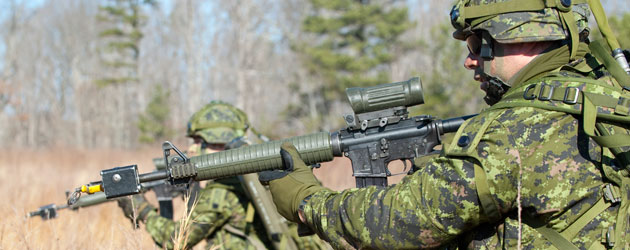
35 Canadian Brigade Group “A” Company conducts the final attack in the training areas of Fort Pickett in Virginia, USA, during Exercise Noble Guerrier. A total of 1600 CF reservists deployed for the exercise.
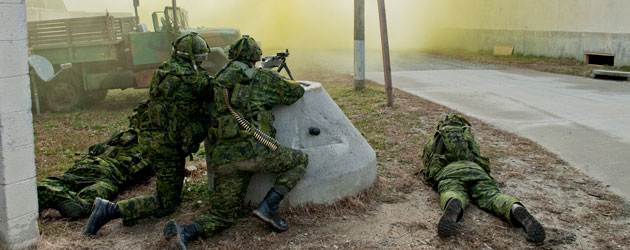
Infantry members of 34 Canadian Brigade Group conduct a demonstration attack in the training areas of Fort Pickett, Virginia, USA, during Exercise Noble Guerrier. A total of 1600 CF reservists deployed for the exercise.
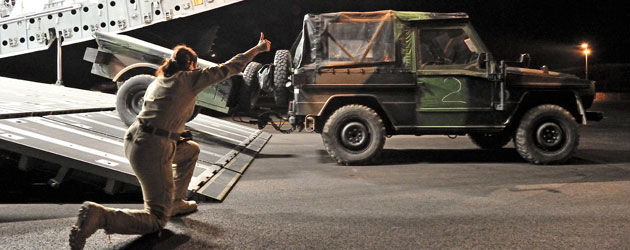
A Canadian Forces Loadmaster gives the thumbs up to the driver of a French military jeep, signaling that he is clear from hitting anything on the CC-177 Globemaster III aircraft at the airport in Bamako, Mali. French forces are attempting to stabilize the country.
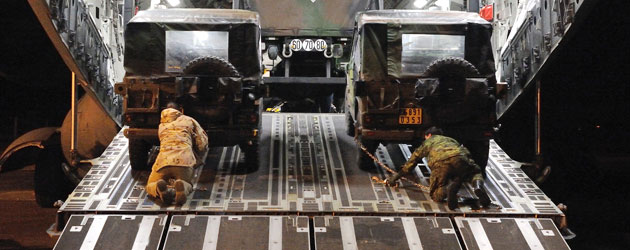
Canadian Forces Loadmaster (left) and another CF crew member secure French military jeeps on board a CC-177 Globemaster III in Evereux, France, prior to being delivered to Bamako, Mali. French forces are attempting to stabilize the country.
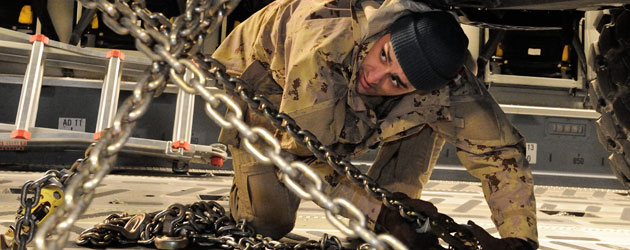
A Canadian Forces Loadmaster uses chains to secure a French military fuel truck on board a CC-177 Globemaster III in Evereux, France, prior to being delivered to Bamako, Mali. French forces are attempting to stabilize the country.

[caption id="attachment_3227" align="alignnone" width="300"] Cdr Martin Drews, the Commandant of Fleet School Esquimalt, explains the capabilities of the new Universal Classroom to VAdm Paul Maddison (centre), Commander of the Royal Canadian Navy, and other command personnel.[/caption] Last Wednesday, naval command was given an introduction into the future of Naval Training.Cdr Martin Drews, Commandant of Fleet School Esquimalt, took VAdm Paul Maddison, Commander Royal Canadian Navy, and RAdm Bill Truelove, Commander Maritime Forces Pacific, through the capabilities of Fleet School’s new Universal Classroom.Gone are chalk boards and overhead screens. In their place is a line of large displays on the walls, HD cameras on the ceiling and personal workstations atop desks. The goal of the specialty classroom is to cut travel costs for those sailors needing to go elsewhere for training. “Instead of sending someone to Halifax or another location, now we can virtually extend the classroom,” explained Cdr Drews. “We can have them learning here, and have the material be delivered from Halifax, or vice versa.” The $397,000 system has been in use for three weeks. It allows DND to seamlessly integrate the classroom in CFB Esquimalt with its sister classroom in Halifax.“If we don’t have an instructor with a certain expertise here we stream them in from somewhere else,” says Lt(N) Jim Meadley, the Training Technology Officer at Fleet School Esquimalt. “It allows us to create flexible and modern learning environments. We could have an instructor standing at the front of the room, we could combine two classrooms, or if the student wanted to learn on their own they could do that at their desk.”This virtual extension of the classroom is done by way of a complex system of HD cameras, monitors, microphones, and touch screens.Thanks to a series of pressure pads, an HD camera on the ceiling is...

[caption id="attachment_3224" align="alignnone" width="300"] PO1 Line Laurendeau (left) stands with fellow CFB Esquimalt Hockey Officials (left to right): CPO2 Yves Ouellet, PO2 Jarrett Taylor, and PO1 George Robinson. CFB Esquimalt is in need of new referees to officiate the numerous games on and off the base.[/caption] There are many things PO1 Line Laurendeau loves about hockey: the teamwork, the chill air of the arena, the flurry and clash of stick on stick. However, having played on CFB Esquimalt’s women’s hockey team for more than 15 years, the time came for PO1 Learendeau to think about her health. Three years ago she made the slide to referee.“I was a goalie, so I knew that my style of play had a shelf life,” says the 40-year-old Sea Cadet Advisor. “I didn’t want an injury to threaten my career, but I wanted to give back to the program and the game.”Becoming a certified official is quite simple; all that’s required are two four-hour classes. One class consists of a review of the game and rules, and the other sees the potential official on the ice, followed by an exam. Once certification is complete, the official is qualified to call hockey games for a number of organizations. PO1 Laurendeau officiates the Intersectional Hockey League for various Canadian Forces games, and the Panorama, Saanich, and Victoria Minor Hockey Associations as well. Just this past year she officiated the Bantam AAA Nationals hosted at the Bear Mountain Arena.“I was up against a lot of male officials a lot younger than me. It was a pretty good feeling to get that opportunity,” she says.Another benefit of being a referee is the increased time on the ice.“When I played hockey that was how I maintained my fitness, but I didn’t get to play all the time,” says PO1...

[caption id="attachment_3221" align="alignnone" width="300"] Ancestry.com is making it easier to access military family history records by teaming up with Library Archives Canada.[/caption] Have you ever thought about creating a family tree, or wanted to learn more about your family history?Information from military attestation papers, birth, marriage and circumstances of death records are now all accessible through www.ancestry.ca, a network of the global ancestry records. “Up until 2006, anyone wanting to view military records of their Canadian ancestors would have to physically visit the Library Archives in Ottawa and look at microfilm or original records,” says Lesley Anderson, Ancestry genealogist and content specialist.Now it’s as easy as logging onto the Internet.“The war graves and circumstances of death register were only viewable at Library Archives Canada. We partnered with them to digitized all the registers and now details like where a soldier was buried, if they were exhumed and reburied, or where they’re memorialized is available online,” says Anderson. An Attestation Paper was the first document a soldier signed before entering the Canadian Expeditionary Force (CEF). In many cases these may be the only surviving record of the enlistment of many Canadian soldiers who fought in World War One. Attestation papers provide a range of details about the enlistee, including place of birth, age, physical description and next of kin. Some also include valuable information about their lives before the war, such as their occupation, marital status and residence. The records of more than 600,000 World War One veterans are now online with billions of historical records from around the world.“Researching family history can be very addictive,” says Anderson.Users can build a family tree adding photos and stories free of charge and then share them with their families.To view the original images of historical records users are charged $9.95 per month for...
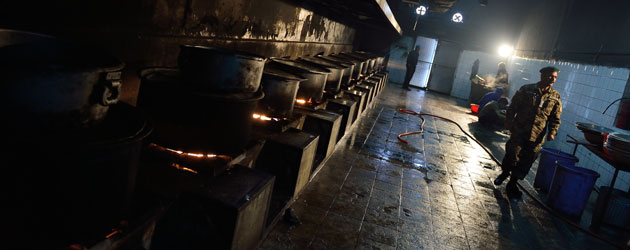
Food is prepared by Afghan National Army cooks at the Army Consolidated Fielding Centre dining facility in Afghanistan.
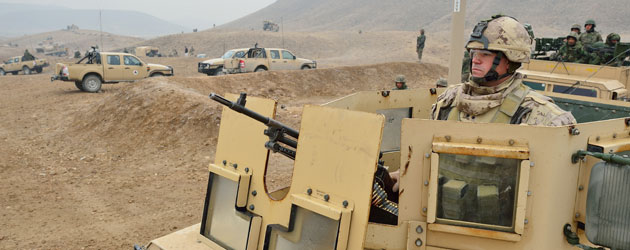
Sergeant Benoit Renaud from 5e Régiment d'artillerie légère du Canada in Quebec City, Quebec, observes a training scenario of the Afghan National Army soldiers, Infantry 2/4/215, at the Consolidated Fielding Centre training area in Afghanistan.
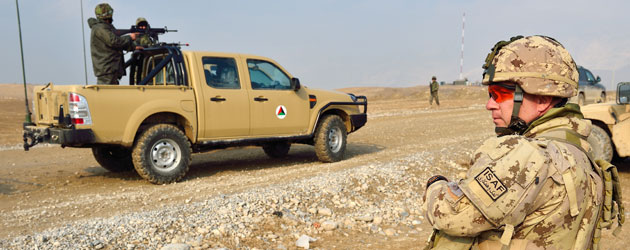
Warrant Officer, Mario Benard, mentor on Operation Attention, observes Afghan National Army soldiers from Combat Support Battalion during training scenarios with improvised explosive devices at the Consolidated Fielding Centre training area in Afghanistan.

Lieutenant-Colonel Jopeph Po, anesthesiology and critical care medical advisor on OP Attention, teaches intra-operative crisis management to Graduate Medical Education residents, professors and staff at the National Military Hospital in Kabul, Afghanistan.
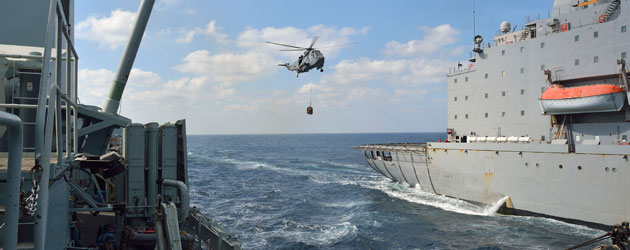
HMCS Regina along with its Sea King helicopter conduct a replenishment at sea (RAS) with United States Naval Ship Patuxent while in the Arabian Sea for Operation Artemis.

[caption id="attachment_3189" align="alignnone" width="300"] Julie Sweeney has created a nine-week self-help program for military spouses that addresses the thoughts and behaviour that can influence body image.[/caption] The Military Family Resource Centre (MFRC) is piloting a new self-help group on Monday nights starting in January and the person behind its creation is a MFRC volunteer. Julie Sweeney developed the program and will act as facilitator for the sessions. Worth Your Weight is a nine-week program that helps military spouses deal with the thoughts and behaviour that can influence body image. The weekly group doesn’t focus on diet or exercise. Instead, participants look deep inside to examine their core beliefs and the issues they have with themselves. The idea behind the program is addressing the inside before working on the outside. “Body image is a common theme amongst women,” said Sweeney on why she wanted to do Worth Your Weight. She started the group to help the women that constantly belittle themselves. The program is her latest effort in the past year to help members of the military family community. “Julie is making a positive impact on people’s lives by filling a need in the community,” said Marianne Ostopovich, a registered clinical counsellor and social worker at the MFRC. “She isn’t waiting for someone else to develop a program, she is taking an active role in helping members of the community.”Sweeney partnered with St. Peter’s Naval Chapel in January 2012 to create the Military Wives Bible Study monthly support group to fill a need in the community. The study takes place on the last Sunday of each month at 6:30 p.m. at St. Peter’s Naval Chapel in Belmont Park.She decided to become a MFRC volunteer in March 2012 in support of her diploma in applied psychology. She got involved helping the counsellors...

Mar 14, 2025
